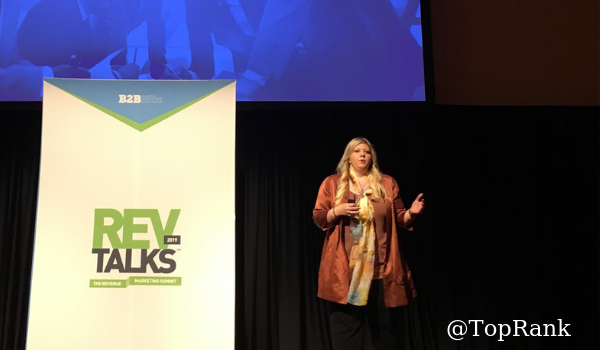
What is the ultimate goal for any business or marketing unit?
There are many valid answers to this question. But I think the subject of Maria Pergolino’s REVTalk on Tuesday morning at B2B Sales and Marketing Exchange (B2BSMX) in Boston offers a worthy aspiration for just about any organization: creating a category.
Brands that are universally held in high esteem and pointed to as shining examples of marketing mastery – such as Uber, Salesforce, and Starbucks – often share this distinction. Their names ring synonymous with what they do.
As a seasoned marketing executive who’s overseen this outcome at a number of different companies over the years, Maria has developed acute expertise on category creation, and offered us a glimpse of her process. Currently, she’s the Anaplan’s chief marketing officer.
“I have lived in very fast-growth organizations,” she said, “and I want to talk about the marketing that has to be done for that to happen.”
Distinct, Comprehensive, Transformative
These three descriptors represent the standard for creating a category. Here’s how she frames each of them in practical terms.
Distinct: You’ve got to be different. Any company that wants to own a category must necessarily be unique from all others within it. It’s not enough to be better; you have to be distinct.
Comprehensive: Your company doesn’t need to do everything. It just needs to do everything that people want from a solution in your specific category. If you have gaps in addressing the needs and wants of your customers, you can bet your competitors will fill them.
Transformative: There’s a misperception that every category-creator needs to reinvent the wheel. As Bandwidth’s Noreen Allen explained in her own “Built to Scale” REVTalk session later on Tuesday, it’s actually smart to join an established fast-growth market, so you can validate your vision with investors and gain resonance with customers. But as Maria implores, you need to transform that market or vertical in a meaningful way.
Pillars of Category Creation
What makes category creation so exhilarating for marketers, in Maria’s mind? We have the opportunity to educate people. You’re not just regurgitating someone else’s talking points or reinforcing an existing paradigm. You’re charting a new course. Or, as she puts it, “You have a better way of doing something, and you’re trying to tell the world about it.”
How do we break through with this original message, though? Maria provides a series of fundamental requirements, adding examples to illustrate.
Establish the Brand
- Clear, Distinct & Stated
- Connects Audience
- Aligned to Product
- Repetition/Drumbeat
Accomplishing each of the above bullets will help generate that mental correlation between your category and brand. As one example, Maria references Sangram Vajre, who delivered Monday’s opening keynote on account-based marketing and its permeation of B2B, noting that he and his company Terminus have staked a claim on the ABM category through alignment and repetition. He’s written multiple books on the topic, runs a podcast about it, and even had ABM imprinted on his shoes at the conference.
Build Demand
- Revenue, Not MQLs
- Scale
- A Shared Approach
- Metrics Based
When you’re forging a new niche, you need to create demand that may not yet exist. People are likely familiar with your broader market category, but the key is driving excitement around your particular area of focus, as opposed to just your product. This means pinpointing pertinent bottom-line metrics, and thinking about scalability early on. Maria remarked upon Sandra Freeman’s Stranger Things-themed ABM presentation from the day before, noting that she appreciated Sandra’s first pointer for avoiding the Upside Down: add “data-driven” in front of every team member’s superpower.
Become the Leader
- Proven
- Innovative
- Network
- Trust
You don’t become a leader simply because you declare yourself one. You do it through your actions. You need to prove you can deliver, exhibit innovation, grow your network organically, and – above all – build trust (something we regularly evangelize at TopRank Marketing).
Align for Success
- Sales
- Product
- Human Resources
- Customer Success
If you don’t have everyone on board, rowing the same direction, the ship’s never going to reach its destination. This means aligning on messaging and your approach in the marketplace. These efforts must be consistent and concerted. She notes that one trend she’s witnessing in accordance with this objective is the presence of HR leaders alongside the CFO in board meetings. This helps provide a voice and conduit for employees at the highest level.
Are your customers, your partners highlighting your brand and bringing you more customers? @InboundMarketer #B2BSMX Click To Tweet
Step by Step, Piece by Piece
One important thing to keep in mind is that creating a category isn’t an instantaneous process. It can be easy to look at a company like Uber and feel like their emergence took place overnight, but there was considerably more work and strategy behind this success.
“Things that we see as trends, things that go viral, it takes a long time for that to happen,” Maria asserts.
Luckily, thanks to her, we now have a blueprint in hand.
Stay tuned for more live coverage of #B2BSMX Boston here on the TopRank Marketing Blog. In addition, follow along in real-time on Twitter at @NickNelsonMN and @leeodden.

Comments are Closed